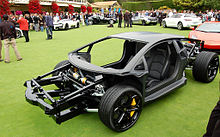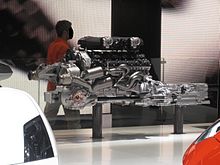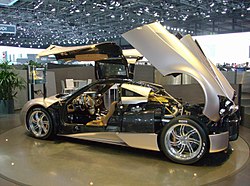| icle to reflect recent events or newly available information. (November 2012) |
The
Lamborghini Aventador LP 700–4 is a two-door, two-seater
sports car publicly unveiled by
Lamborghini at the
Geneva Motor Show on 28 February 2011, five months after its initial unveiling in
Sant'Agata Bolognese.
[2] Internally codenamed LB834,
[3] the Aventador was designed to replace the ten-year-old
Murciélago as the new flagship model in the Lamborghini lineup starting in 2011.
[4] Soon after the Aventador unveiling, Lamborghini announced that it had already sold over 12 months of the production vehicles, with deliveries starting in the second half of 2011.
[5]
In keeping with Lamborghini tradition, the Aventador is named after a bull. The Aventador was a bull that fought particularly valiantly in the bull ring of Saragossa, Spain in 1993.[6]Name
[edit]Aventador LP 700-4
Production will be limited to 4,000 units (4,099
Murciélagos have been built). The
molds used to make the
carbon-fibremonocoque are expected to last 500 units each and only 8 have been made.
[7] The first 1,000 Aventadors were built in 15 months.
[8][9]
The car's shape also borrows heavily from Lamborghini's limited-edition
Reventón and their
Estoque concept car.
[edit]Specifications
The Aventador LP 700–4 uses Lamborghini's new 700 PS (510 kW; 690 bhp) 6.5 litre 60°
V12 engine weighing 235 kg. Known internally as the
L539,
[3] the new engine is Lamborghini's fourth in-house engine and second V12. It is the first all-new V12 since the
3.5 litre powerplant found in the
350GT.
[10]
| Displacement | 6,498 cc (396.5 cu in) |
| Max. power | 700 PS (510 kW; 690 bhp) @ 8,250 rpm |
| Power to weight | 432 PS (318 kW; 426 bhp) per tonne |
| Max. torque | 690 N·m (510 lb·ft) @ 5,500 rpm |
| CO2 emissions | 398 g/km |
| Combined fuel consumption | 17.2 L/100 km (16.4 mpg-imp; 13.7 mpg-US) [11] |
[edit]Performance
- 0–62 mph: 2.9 s [12]
- 1/4 mile: 10.6 s @ 137 mph (220 km/h)
- Top speed: 217 mph (349 km/h), 354 km/h[13] GPS
- 60–0: 100 ft.
The new, electronically controlled,
all-wheel drive system is developed and supplied by the Swedish company
Haldex Traction, offering traction
[16] and handling capabilities based on their 4th generation technology.
[17]
[edit]Aventador LP 700-4 Roadster
The 2013 Aventador LP 700-4 Roadster was announced for production in November 2012, equipped with the same internals as the coupe version, Lamborghini claims again that it can reach 100 km/h (62 mph) in 2.9 seconds and a top speed equaling that of the coupe, at 349 km/h (217 mph). The removable roof consists of two
carbon fiber panels, weighing 6 kg (13 lb) each, which required the reinforcement of the rear pillar to compensate for the loss of structural integrity as well as to accommodate the rollover protection and ventilations systems for the engine. The panels are of easy removal and are stored in the front luggage compartment. The Aventador Roadster has a unique engine cover design and an attachable wind deflector to improve cabin airflow at high speed as well as a gloss black finish in the A-pillars, windshield header, roof panels, and rear window area. The car has a $441,600 base price. With a total weight of 1625kg it's only 50kg heavier than the coupé (the weight of the roof, plus additional stiffening in the sills and A-pillars).
[18][19][20][21]
[edit]Special editions
[edit]Aventador J
Six months after unveiling the Aventador, plans for a roadster version were leaked by the U.S.
EPA after it included the model on a data sheet on its website. Lamborghini officially unveiled the Aventador J to the world at the 2012
Geneva Motor Show.
[22] The roofless and windowless concept car uses the same V12 engine as the standard Aventador, producing 700 hp through a lightweight seven-speed automated transmission. The car does not have air conditioning or radio to save further weight for a total of 3,472 pounds (1,575 kg).
[23][24] The car presented at the Geneva show was the only unit to be produced, and was sold for
US$2.8 million. Another Limited Edition model was made for Shaikh Al Yahyaa and was sold at an unknown price. The car was specially made for a close relation.
[25]
The J designation was thought to have come from Appendix J in the
FIA rulebook that describes the technical specifications of race cars.
[26] However during an interview with designer Filippo Perini, it was revealed that the 'J' actually stands for Jota, in reference to a 1970s one off Lamborghini Miura Jota which also conformed the FIA's Appendix J regulations.
[edit]Dreamliner Edition (2012)
It is a version of Aventador LP 700-4 coupe with blue and white body colour scheme from
Boeing 787 Dreamliner, pitch-black wheels.
The vehicle was unveiled in 2012 Aerospace & Defense Supplier Summit.
[27]
The
Lamborghini Veneno is a limited production
sports car, first exhibited during the 2013
Geneva Motor Show. It is a show piece based on the Lamborghini Aventador and was built to celebrate Lamborghini’s 50th anniversary. The prototype, Car Zero, is finished in grey and includes an
Italian flag vinyl on both sides of the car. The engine is a development of the Aventador's 6.5 L V12 and produces 750 PS (550 kW; 740 bhp).
[28]
Only three production cars will be produced. There will be a green, white, and red one, each representing a colour of the
Italianflag. Car Zero, which was the vehicle on display,
[29] will be retained by the factory for the museum. The three production cars will cost €3.12 million each, and all three have been sold.
[30] Two are destined for the USA.
Veneno means 'Venom' in Spanish and Portuguese.
[edit]LP 720-4 50° Anniversario (2013)
At the April 2013
Shanghai Motor Show, Lamborghini announced the Aventador LP 720-4 50 Anniversario Edition, meant to commemorate the 50th anniversary of the company. This special edition Aventador makes an extra 15 kW (20 bhp) above the stock version of the car, includes a more aggressive aero kit made primarily out of carbon fibre, comes equipped with gloss black versions of the Aventador LP 700-4 Roadster wheels, and is offered in only one colour: Giallo Maggio (Italian for "yellow May"). The addition of the carbon fibre aero kit gives the car 50% more downforce than the standard Aventador.
[31] Lamborghini will only produce 200 examples of this car (100 coupés and 100 roadsters).
[citation needed]
[edit]Reception

Unibody as used for the supercar Lamborghini Aventador LP700-4
Automotive magazines such as
Car and Driver and
Motor Trend reviewed the Aventador.
Car and Driver titled their article "The best Lamborghini ever."
Motor Trend described it as "the friendliest V-12 supercar in the world." Praise for Lamborghini's all-new V-12 powerplant centered on the engine's responsiveness, torque, and smooth power output. Criticism centered mainly around the Aventador's unrefined single-disc clutch.
[32][33]
On 31 July 2011, the Aventador was reviewed by the motorsport show
Top Gear. Host
Richard Hammond was impressed with the performance and handling of the car. His biggest complaint was a nostalgic poke at the Aventador's accessible temperament, implying that it left him longing for the "danger" associated with driving previous Lamborghini supercars.
[34] The Aventador posted the third fastest time ever recorded on the
Top Gear test track with a time of 1:16.5, beating the $2,000,000
Bugatti Veyron Super Sport, the
Enzo Ferrari, the
Porsche 911 GT3, and other supercars from around the world. In episode 18 of the program cohost Jeremy Clarkson says the Aventador is better than the
Ferrari 458 Italia (which they called the best super car ever), describing it as being "£200000 worth of dreams."
[35] The Aventador won the "Supercar of the Year 2011" from
Top Gear.














0 comments: